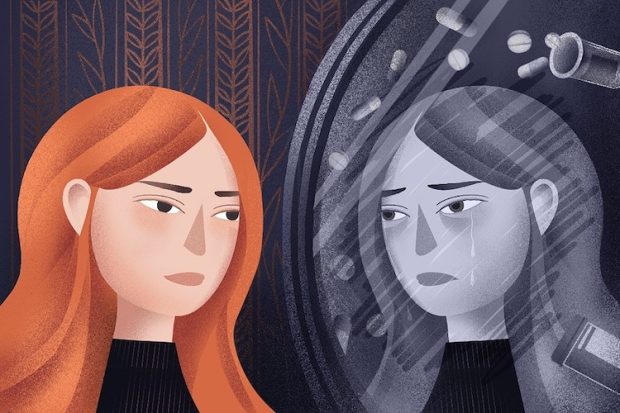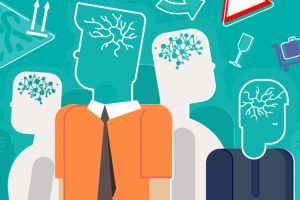Microbiome
Biologist Tim Spector on the overall weight of our microbes, remembering our natural roots, and the importance...
Bipolar disorder is a psychiatric disorder, a mental disorder which is characterized by episodes of either depression, which is low mood and exhaustion and mania, which is characterized by high mood and increased energy. These states alternate with each other over a lifetime, and they can be extremely difficult to manage and very difficult and destructive to patients’ lives.
What we see when we first see someone with depression or mania is a very clear change from their normal state. This usually happens or starts for the first time between the ages of 15 and 25; it’s not invariable that that happens, but that’s the commonest way in which it starts. When it starts with depression, it is difficult to diagnose because depression could simply be common or garden depression, not bipolar disorder. You’ve got to have a manic episode before you can say that someone has bipolar disorder and that sometimes takes a little while to materialize and to manifest. So when you have seen a manic episode in a person, then you know that they have a pretty long haul ahead of them, and you’ve got to think carefully about how you should propose treatment.
How do we recognise mania? Mania presents with increased energy, reduced need for sleep, tremendous enthusiasm, and overconfidence. This can even get to the level of becoming psychotic, and people become quite deluded about their powers, their abilities, and the prospects that are ahead of them. Sometimes, in those circumstances, they make really bad decisions, which can be about money, about their relationships, about taking big risks generally, be they physical, psychological, or monetary. Those risks often translate into minor disasters or quite major disasters for people. So when people develop mania, it’s important to try and cut it short, and that’s often a reason why people come to a psychiatric hospital for the first time. We continue to have to use psychiatric inpatient facilities to look after people with mania.

What is a longer-term problem for these people, however, is usually the depression. The depression kind of follows the mania often, rather like the night follows the day. Depression is something that the patients really don’t like; it’s extremely unpleasant: people feel a lack of energy, they lack interest, they lack any kind of optimism for the future, and they may very well get suicidal and feel suicidal. Indeed, I’m afraid that suicide is not uncommon in patients with bipolar disorder. It’s usually in the first phase of their life with the disorder that it occurs, so this is often happening to young people, and that’s in its way is often a tragedy.
So, that is the outline of the disorder. What causes it? We think now, and we’re pretty confident that most of the causation lies in genetics, but those genetic causes are filtered obviously through one’s environment: one’s growing up in a particular setting one’s experiences. Although we don’t think that those are fundamentally important, if they’re very adverse, then they often make the course of the illness worse. So if you have a bipolar genetic risk and you also have very difficult early experiences on top of that, then very often the bipolar disorder is worse. So that’s a kind of cocktail that we unfortunately often see in our patients, and that makes them more severely ill.
But genetic causes are now increasingly understood to be not just a single gene or several genes but many genes and these genes all exercise a minor effect.
The analogy that we usually use is between getting a deck of cards. You get a hand of cards, each card is maybe slightly different (we have variation in our genes, in our set of cards), and you play that set of cards as if it were your life’s chances. If your life chances are loaded up for bipolar disorder, then that’s often the way it goes. If you are an identical twin of someone with bipolar disorder, the chances you get it are extremely high, about 80%. If you’re a non-identical twin or a brother or sister, then those risks are very much lower, and if you’re a child of someone with bipolar disorder, the chances that you get the illness is only about 6%. So it’s a genetic disorder, but it’s not due to single genes. We can’t imagine treating it by eradicating the genes, but we do have to think about how we treat it because, with many people, it’s such a very difficult problem.
The main way in which we treat it is that we have to look at the different phases of the illness. So if you look at mania, because it’s such an emergency, because people are often so disturbed, because their behaviour is so abnormal, we usually have to use medications. Those medications can be difficult for the patients to accept. They’re usually based on the blockade of dopamine function in the brain, and the drugs are sometimes called antipsychotic drugs. The classic antipsychotic drug that was invented a long time ago was chlorpromazine: when it was first invented in the 1950s, it was actually used on manic patients. We continue to use the newer versions of chlorpromazine to treat the acute phase of the disorder, and it’s important that we do that so that it wouldn’t be too prolonged, people wouldn’t stay in the hospital for too long, and we wouldn’t get the consequences of a profound and prolonged overactivity which in the past used to be in themselves quite dangerous. So, getting people out of their manic episodes is relatively straightforward, and at least there’s a formula for doing it.
Depressive episodes are rather more difficult. Depressive replicas may spontaneously get better, but treating them is often quite tricky, and we often have to have patience. There are a number of medications available for that, and we also use various forms of psychological treatment that seem to help.
But getting people better from depression is more difficult, and depression more often becomes rather chronic so that people remain somewhat depressed after their recovery from mania or the recovery from severe depression.
That’s very troublesome for them. It’s also easy for us to accept that outcome because the problem lies with the patient, so you have to work quite hard to make sure that people make a full recovery.
What keeps people well is a range of things. One is that they have to make important lifestyle choices, for example, if they have a particularly up-and-down sort of world in which they’re forever running themselves to the max on the one hand and then collapsing on the other. Certain sorts of lifestyles lend themselves to that. If they’re using stimulant drugs, cocaine or indeed probably cannabis, we think that that’s a bad idea for those people, or if, in addition, they are taking upon themselves massive risks and pressures which are putting them under major strain, we think that those sorts of things people have to be realistic about. So it’s difficult sometimes for them to make the adjustments because they’re used to kind of running their engine at full speed, and that’s not something they can probably continue to do.
There are other medications that are used. Often, originally, they were used in epilepsy. We don’t quite understand what the link between epilepsy and bipolar disorder is, whether there’s some sort of common pharmacology, some common ground on which the pharmacology works, but nevertheless, they do seem to be useful. There are drugs like lamotrigine and others that are used to manage patients with bipolar disorder in the long term.
Finally, we think that it’s very important for patients to understand their illness. Part of the role of the psychiatrist is to communicate to the patient the risks around their illness, what shapes it, what precipitates episodes and what they can do to reduce that. We often call that psychoeducation, and that’s the foundation of the relationship that the doctor must have with the patient.
And if you get the formula right between psychoeducation on the one hand which is essentially psychological or behavioural education and medication on the other and you strive to avoid the adverse effects of the various medications that we use then you can often come up with a way for people to live pretty securely with their illness.
Unfortunately, that’s not true of everybody, and for those people for whom it’s not true, bipolar disorder is a very major burden. Even for those for whom we’re successful, they are often less able to earn a living at the level they would have expected to, and they have to make very major adjustments.
Bipolar disorder is one of these conditions which really challenges the individual. It affects in its more severe forms about almost one in a hundred people, and in its milder forms, it affects another one in a hundred people. So it’s pretty common: if we know about 200 people, the chances are we know at least one person with bipolar disorder. So it’s not something that’s far from another: it’s part of all our lives, and it’s something we need to know about.

Biologist Tim Spector on the overall weight of our microbes, remembering our natural roots, and the importance...

People fail at remembering even basic information about objects they were looking at

Microbiologist Kim Lewis on chronic relapsing infections, persister cells, and Metronidazole